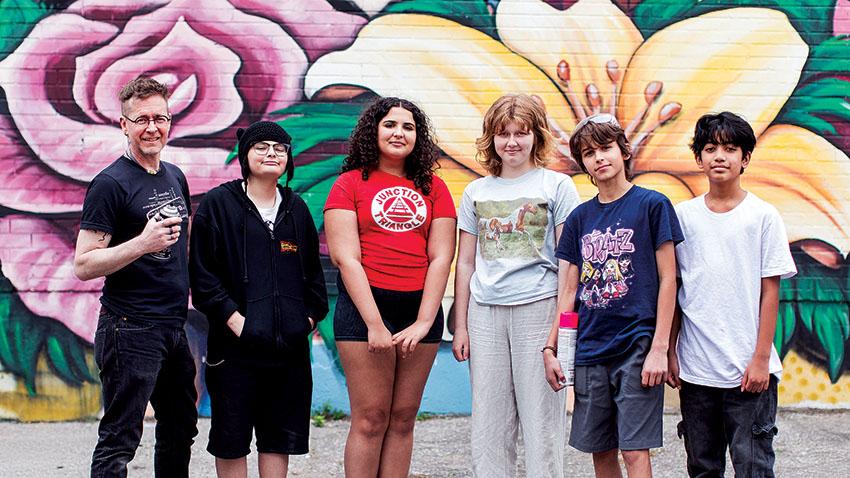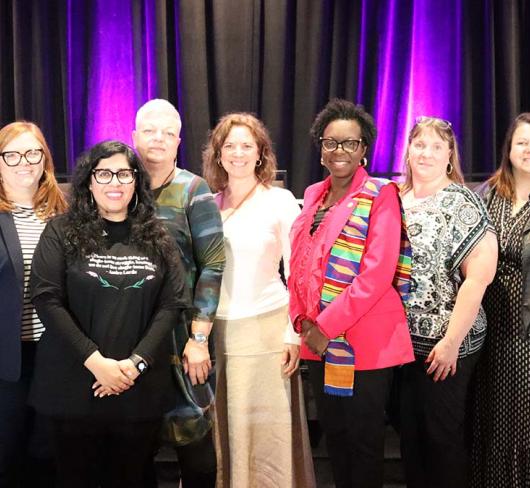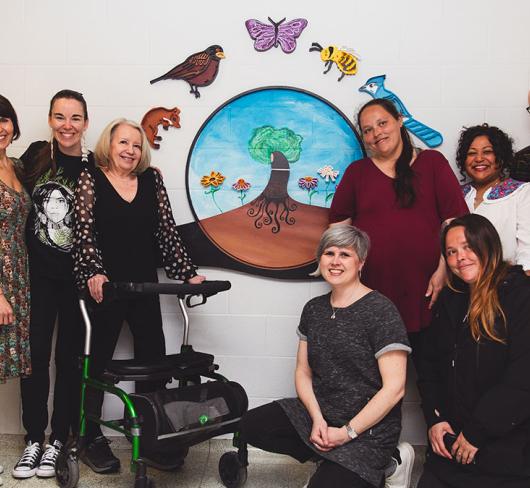
Becoming Banksy
We’re standing in front of a massive mural on a street near our school, the faces of happy children smiling at us from a cinderblock wall. The piece is a collaborative project between Canadian and Chilean muralists. The artist is political activist Giovanni Zamora, and the Grade 8 class observing it is asked what they think is being communicated through the artwork.
“Children are the future!” someone suggests with a groan. Clearly, he’s been around this block before.
“Hope? It says ‘hope’ on the kids’ shirts,” replies another student.
“Well, it’s true that this mural is called Roots of Hope,” I offer. “But why hope? Let’s continue this conversation when we get back to the classroom where you can do some research.”
During the 1970s and ’80s, many Chilean refugees made our neighborhood in west Toronto home after escaping the military dictatorship of Augusto Pinochet. The students discover that the Canadian and Chilean governments have been close friends for a long time. So close, in fact, that it took a mere three weeks for the Canadian government to recognize Pinochet’s leadership following the 1973 coup he led with his military junta. Thousands died, tens of thousands were tortured, and hundreds of thousands were exiled.
“Our government recognized Pinochet?”
“Quickly, yes.”
“I didn’t know that…”
We’ve been thinking a lot this year about the idea of making the invisible visible, as a crucial first step in responding to injustice. As we turned the corner into springtime, I wanted to create classroom time for students to take up space in a new way. That’s when the spray-paint cans came out onto the front desk.
Making Their Mark
It’s International Women’s Day. I’ve introduced the graffiti art project: find a woman who inspires you, print a stencil of the person, cut it out and spray-paint her image on the walls of our hallway. Today, next week, next month. Whenever you like.
“Do you mean we get to spray-paint on the wall? Like, it’s not coming down?” asks Maddy.
There’s something powerful about permanence. The kind of mark that’s not peeled off the wall in the sweltering last days of June. I bump into one of our teacher candidates, Roddie, who is musing about this tiny hallway. “There’s something here about permanence in a space you’re passing through,” he says. “And connection, making yourself a part of a place.” He’s also talking about the idea of diffusing power in a learning community. Now I’m musing along with him.
There’s something important, too, about an ongoing invitation, an inoculation against a blinkered view of justice where special days and months are celebrated, but there’s no sustained, year-round integration into the curriculum or young people’s lives.
Our students have become cautious about doing things to “tick the box.” Ives, in Grade 7, says, “I think having special days and months is good because it very much encourages people to talk about things that they normally wouldn’t. But unfortunately, it fuels a narrative: ‘I talked about it in Black History Month or on Pink Shirt Day — now I’m done.’ It definitely gives people an excuse to ignore or look away from very important topics and not feel bad about it.”
Mabel continues: “These significant days and months should be a starting point, not a stopping point.”
Let's Get Technical
The technicalities of stencil art are straightforward. Teach students how to carefully use a utility knife. Suggest some search terms, including “stencil,” to pull up people they want to see on the wall. If they can’t find a stencil, there are websites that will turn your favorite photos into one. Print out the image and begin cutting on a surface that has a little give. Reclaimed book covers were our surface of choice.
Some students find that inking the parts of the stencil they’ll be cutting out makes the process clearer. After some safety training, I make a soldering iron available to burn out fine details like eyebrows, lips, and pieces of the eyes and nose. Regardless of good instructions, a student will inevitably cut out too much and lose the whole face. No matter, try again.
When students are satisfied with their work, they tape their stencil within a larger bristol board frame that will help protect the wall as the spray paint is applied. Students choose the paint colour and gear up with safety goggles and a mask. Light, back-and-forth bursts of paint a foot from the wall work well; too much and the paint will run.
To finish the piece, students find sites online that have information about the person they chose, and they create a QR code that they can paste to the wall next to their art. The sites might be Wikipedia pages about the hero, or pages for books they’ve written, information on breakthroughs they’ve made in science or society, or even music videos they’ve created.
We Don't Need Another Hero?
The stencils begin going up. Autumn Peltier. Viola Desmond. Alexandria Ocasio-Cortez. Simone Biles. Tracy Chapman. Angela Davis. Marie Curie. Miss Peppermint. Some are familiar, some not at all.
It’s as we’re talking about our rapidly emerging “hall of heroes” that a Noam Chomsky quote crosses my mind and threatens to ruin it all: “We shouldn’t be looking for heroes, we should be looking for good ideas.” Chomsky’s good idea is messing up my plans. I have to consult with my students.
“Is our hallway of heroes fundamentally flawed?” I ask, a trickle of sweat running down my brow. We’re waist-deep in this project. Ivy in Grade 8 pauses for a second or two and then responds. “The idea of heroes creates a culture where people think someone else will do all of the work; but finding inspiration within yourself is really important. In reality, everyone has to do it.” Perhaps a stencil of Ivy should go up on the wall with this good idea.
The conversation turns to the importance of putting a QR code next to the stencil. Ruthie observes that “all of the people in our graffiti alley had good ideas. That’s where all of their activism came from.” The conversation around the room is animated and we’re just about to wrap up for lunch when Xavier slips in a final word. “We should’ve made the QR code bigger than the person!” It dawns on me that if we’re going to focus on ideas, it’s time to introduce Banksy.
Love is in the Bin
We are watching a video of the 2018 auction of Girl with Balloon, a piece of graffiti art by the anonymous artist Banksy. As the gavel falls for a bid equivalent to $1.4 million Canadian, those in attendance at Sotheby’s auction house in London turn in shock as they suddenly see the art feed through a shredder hidden within the bottom of the frame. It jams halfway through its descent, leaving tentacles of Girl with Balloon trailing below the frame. The piece is renamed Love is in the Bin and is resold three years later for 18.5 million British pounds (about $32 million).
Let me be the first to say that I’m no expert on Banksy. But what I do know is that his graffiti art is about ideas: satirical social commentary, particularly critical of power and oppression, hypocrisy and greed, militarism and police brutality, and the cozy relationship between capitalism and fascism. Every piece is an opportunity to have a conversation. Similarly, every painted wall we come across in our own neighbourhood an invitation to learn and to reflect.
Enter Kimberlé Crenshaw
Clara and Kaya, two Grade 8 students in my media studies class, are making a documentary on the topic of intersectionality. Kimberlé Crenshaw coined the word as a way to describe the compounding nature of race, class and gender inequities, among other factors. Clara has decided that Crenshaw must be on the wall and begins to make her stencil.
Our graffiti hallway is slowly evolving, showcasing a wider and wider range of personalities. Students have interviewed Chandra Talpade Mohanty, a professor of women’s and gender studies, sociology and cultural foundation of education at Syracuse University, who prompts them to think of intersectionality as the opposite of singularity. “Intersectionality is so important,” she tells them, “because it draws our attention to the fact that a single story or a single narrative is always very limited.”
We use this idea to ask, “who is on the wall?” and, just as importantly, “who isn’t?” Who gets sanctioned, like Zamora’s mural near the school, and who doesn’t? As they choose the subject of their stencil, some are surprised by who has been missed. “I can’t believe Coretta Scott King isn’t in our hallway yet!” “Where are the young activists?” “Where are our transcestors?” Clearly, we have work to do.
"Get in Good Trouble, Necessary Trouble"
I’m reminded of these words from John Lewis, a civil rights activist and longtime politician from the United States, when I think about graffiti and the law. Students know that it’s an offence to spray-paint on public and private property. As criminal lawyer Mark Zinck writes on his website, “It doesn’t matter if it is an old dumpster at the bottom of a dark lane, or the front doors of Toronto City Hall, if the police catch you tagging, they will charge you with mischief.”
So, do my students think I’m encouraging them to break the law?
“No,” rings out quickly across the room. “It’s our wall and we had permission.”
“Not exactly,” says Isabelle. “That’s a complicated question.”
And then, slowly, a few people say yes.
“People who break the law could be showing that the law was wrong,” Audrey begins.
“I saw a documentary on the weekend, about Indigenous rights and how the Canadian government and the oil and gas companies wanted to put a pipeline through their land,” Cleo shares. “So the Wet'suwet'en people put up blockades.”
The moments when protestors have broken the law to advance social justice begin to spill out. People protesting a dictatorship. Rosa Parks and the bus boycott. Women fighting for the right to vote. Highways shut down in support of Palestinians. The lunch counter sit-ins as a strategy to fill up the prisons.
“There was a time when I wouldn’t have been able to go to the same school as Ivy, or use the same washroom, or drink from the same water fountain,” says Kora. The gravity of this question is sinking in.
“I know someone who is in a bad situation and lives outside on the street. They will do something illegal, especially in wintertime, so that they’ll be arrested and put in prison with food and a bed,” says Sachi.
“Ok then, how about the January 6 rioters?” I ask. “They thought that the 2020 U.S. election was rigged, they wanted their votes to count and make a difference, and a bunch of them definitely broke the law while at the Capitol. So, what’s the legitimate criteria for breaking the law? What counts as ‘good trouble’?”
“I’m a strong believer in science and facts,” says Ivy pointedly. Indeed. The 67 lawsuits claiming widespread election fraud were all dismissed or dropped and followed quickly by defamation cases against Trump and his allies. Evidence matters.
Others point out that intent to uphold or to take away human rights also matters. And, most importantly, whether protestors are taking part in non-violent civil disobedience. “Some of the rioters on January 6 wanted to hurt other people. They did hurt other people,” says Audrey.
We near the end of our discussion with a quote from Banksy’s book Wall and Piece: “The greatest crimes in the world are not committed by people breaking the rules. It’s people who follow orders that drop bombs and massacre villages. As a precaution to never committing major acts of evil it is our solemn duty never to do what we’re told, this is the only way we can be sure.”
Finally, we circle back to Isabelle’s remark: “It’s a complicated question.”
A Starting Point, Not a Stopping Point
My teacher candidate Simon has been reflecting on the significance of our graffiti alley. “Students had ownership of this project – they discovered that every one of them had the ability to create a beautiful piece of art with deep meaning,” he says. “The buzz of excitement and discovery as students pulled out their phones to scan the QR codes and the echoes of excited conversations as new learning took place were inspiring. What struck me was their deep understanding of what was happening. The medium was the message, and it created the circumstances for an inclusive, expressive, relevant piece that students were so proud of.”
Banksy writes, “When you go to an art gallery you are simply a tourist looking at a trophy cabinet of a few millionaires.”
But here, in this tiny little hallway – this place feels different.
David Stocker is a member of the Elementary Teachers of Toronto.

